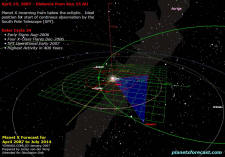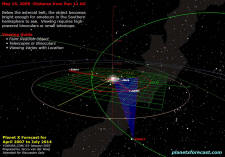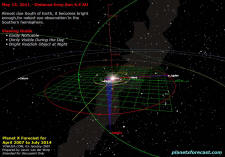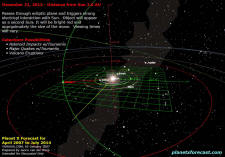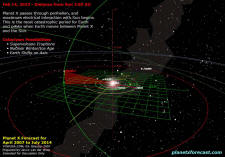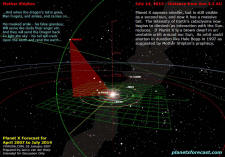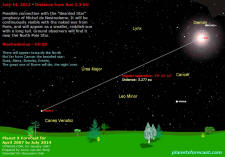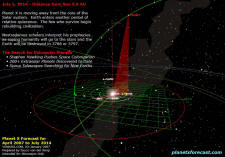|

by Jacco van der Worp
Foreword by Marshall Masters
26-April-2006
from
Yowusa Website
America is now spending huge sums to deploy the massive
South Pole
Telescope (SPT) in Antarctica.
The final installation will be
the size of a mini-mall and will require a massive C-130 airlift
effort to transport pre-assembled modules and a large staff to the
most desolate, inhospitable and inaccessible region of the world.
Why? Because Planet X / Nibiru was first sighted in
1983 and this
discovery spurred the USA to build the SPT — humanity's new Planet X
tracker.
Amongst independent researchers like us at YOWUSA.COM and the
equally committed researchers with whom we share data, the 1983 IRAS
observation of Planet X / Nibiru has always been a hot topic. On a
private level, we often discuss how the NASA's IRAS spacecraft first
captured infrared images of it back in 1983 with the same lament.
Given the lack of corroboration, how can you publish a story that
can easily be shot down as a rumor? That was then.
Now we have the corroboration we've lacked for years, The South
Pole Telescope (SPT). Far more powerful capable and survivable than the
1983 IRAS spacecraft and Hubble Space Telescope put together, this
manned observatory will soon begin tracking Planet X / Nibiru from
the pristine skies of Antarctica.
Why is America spending a massive fortune to transport this massive
facility with massive C-130 airlift to the most desolate,
inhospitable and inaccessible region of the world to track this
massive inbound? Because this is where astronomers will find their
ultimate Kodak moment and this is good news.
Their resulting
multi-spectrum observations will translate into life-saving data.
Foreword by Marshall Masters
A key person in the revealing content of this article is a former US
intelligence officer by the name of John Maynard.
These days, he is
best known for his involvement with
Dr. Steven Greer’s Disclosure
Project. With regards to this article, his explanation of how our
government first began tracking Planet X / Nibiru in 1983 is now
being corroborated with the deployment of the South Pole Telescope (SPT)
in Antarctica.
When I starting YOWUSA.COM in 1999, I received a good deal of help
from John. Not one to remain idle, he took a position with the World
Bank, to begin running their Africa desk following his retirement
from the National Reconnaissance Office (NRO). The NRO develops,
deploys and operates America’s reconnaissance satellites for
“customers” like the Central Intelligence Agency (CIA) and the
Department of Defense (DOD).
As a former intelligence handler, John’s goals were two-fold.
-
First,
the release of information he’d seen pass across his desk regarding
space threats and extraterrestrials.
-
Second, and of equal importance
to him, was teaching those who committed to publishing on these
topics how to avoid confrontation with the Machiavellian-oriented
groups within our government.
His advice greatly shaped the manner
in which we publish our findings to this very day.
When I started this site in 1999 along with Jacco van der Worp,
Steve Russell and Janice Manning, our focus was solely on Earth
changes. Rather than follow the footsteps of a narrow Earth-centric
debate centered on humanity’s impact on the biosphere, we opted to
see if there was an off-world causality. In late 2000, we determined
there was, and this led us to our present research efforts with
regards to Planet X / Nibiru.
In late 2000, I also had several conversations with John regarding
Planet X. Actually, I probed him rather hard. Having worked on the
Denver-based Space Imaging satellite project for Lockheed Martin, I
knew if a large incoming object was on the way, the Hubble or some
other deep space bird had likely imaged it. My hunch was on the
money.
John finally told me it had been imaged by NASA’s IRAS infrared
sensing satellite in 1983 and that the mechanical failure story was
used as a cover story. As he explained it to me, the IRAS data
started pouring in, and that’s when they found Planet X. During one
sweep, it stood out like a sore thumb; worse yet, it is approaching
from the South.
This was especially bad news because the vast majority of the
world’s most capable observatories are north of the Equator, and the
decision was made to devote the remaining lifespan of the IRAS
spacecraft to the observation of this one object.
After releasing the mechanical failure cover story, controllers used
the IRAS’s remaining fuel to maintain a constant track on the object
until they finally lost all control of the spacecraft.
Why IRAS Was Sacrificed
The reason why it was necessary to expend the IRAS’s remaining fuel
is that tracking an object to determine its speed and trajectory
requires multiple observations. This is because the more
observations you make, the more you increase the accuracy of your
tracking calculations.
This is why many Near Earth Object (NEO) announcements are alarming
at first and then gradually become less threatening. As new
observations are made, the chance of impact typically decreases
through more accurate calculations.
The Internet is currently abuzz with interest for what is fondly
called Planet X. Whether Planet X is nothing but wild speculation or
the subject of serious investigation, if you know what to look for,
chances are you will find it. The debate about whether it exists at
all or not continues to rage. Yet, most scientists in need of
research funding will stay clear of going against accepted theory;
when asked, they will proclaim the official dogma:
"There is no such
celestial body. If there were, we would have observed it by now. We
have not; therefore, it cannot be there (Quod erat demonstrandum -
which was to be proven)."
Coming from the mouths of reputable astronomers, this usually kills
any debate before it even starts. Or perhaps it does not quite kill
it totally; in spite of vehement denial by almost everybody
connected to the astronomical society, the Planet X debate simply
refuses to die off. Better yet (or worse, depending on your point of
view), it grows stronger almost day by day.
Thanks to the continuing stream of mission and project announcements
that, on the surface, seem to defy logic altogether, this debate
lives on. We will look at one of these seemingly logic-defying
projects in this article.
We see a strong indication that something is afoot indeed, something
quite big.
A Telescope on Antarctica
The above title should have raised at least your eyebrows if you
keep up with the news and know a bit about international politics.
But it is true; a telescope, a rather large one at that, is under
construction on
Antarctica, which is the South Pole continent. Most
people would not want to be found dead on that barren, frigid world,
and chances are you would end up frozen to death if you go there.
The continent is a cold and lifeless hell; it is no place for any
human activity, for sure.
Nevertheless, the
University of Chicago, together with those of
Berkeley, Case Western Reserve and Illinois, and the Smithsonian
Astrophysical Society are working on a project to build a telescope
on Antarctica, at a stone’s throw from the geographical southernmost
tip of the world.
Airborne Composites
Latest news, March 2006
This month Airborne Composites, The Netherlands, will complete the
manufacturing of the Back up Structure for the South Pole Telescope
(SPT) at their Ypenburg, The Hague premises. Early 2005, Airborne
was selected as contractor for the delivery of this 10 meter
diameter carbon fiber dish by General Dynamics VertexRSI in San
Jose, USA.
Each component is designed so that it can be broken into parts that
will fit in an LC-130 aircraft, which can carry about 11 metric tons
and has a maximum cargo bay width of 3 meters. The installation
window on the South Pole is only 2 months due to the severe weather
conditions. The SPT is planned to be ready for operation in 2007.
The ready-to-assemble parts are being built right now in places
around the world and will soon be flown to Antarctica to be
assembled on-site.
Moving South or Into Space
The project website states they want to look at Cosmic Microwave
Background Radiation, in order to help determine the structure and
age of the universe and to confirm whether the expansion of the
universe is actually accelerating.
South Pole Telescope
A new 10 meter diameter telescope is being constructed for
deployment at the NSF South Pole research station. The telescope is
designed for conducting large-area millimeter and sub-millimeter
wave surveys of faint, low contrast emission, as required to map
primary and secondary anisotropies in the cosmic microwave
background.
Remarkable progress has been made in the characterization of the
cosmic microwave background radiation (CMB) over the last several
years. It was nearly 30 years after the initial discovery of the CMB
by Penzias and Wilson in 1965 before small differences in its
intensity were measured by COBE and its spectrum was shown to be a
blackbody to high precision.
Yet, this statement does not explain why the telescope needs to be
in such a remote, inhospitable location as near the South Pole.
Central Siberia offers equally dark night skies and a stable
atmosphere too; it has almost equally cold winters, and it is much
more easily accessible from the US and Europe, the origins of the
construction parts of the telescope and the places the crews come
from.
|


